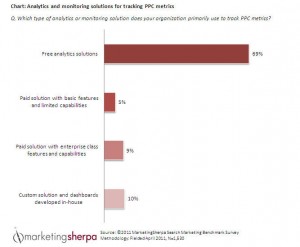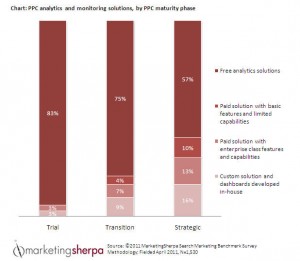PPC Marketing: A look at analytic and monitoring tools
Here at MarketingSherpa we are always looking to bring you actionable tactics and interesting insights based on surveys of your marketing peers. You can pre-order our latest research — the 2012 Search Engine Marketing Benchmark Report – PPC Edition. Better yet, you can even download the executive summary from the report at no cost.
The direct download of this excerpt is free and does not require registration.
In the executive summary you’ll find six charts outlining the key findings from our research, but one of the perks of working here at Sherpa is I get the chance to take an early look at entire report (and the rest of the 125 charts.)
During this sneak preview I found a couple of charts that highlight an area where many marketers can improve their pay-per-click efforts.
Analytics and monitoring — is “free” enough?
Here is a breakdown of the types of analytic tools companies are using with PPC campaigns:
As you can see, 69% of surveyed marketers use free analytics solutions for pay-per-click efforts.
One common aspect across all types of analytic tools from free to enterprise-class paid solutions is they are all pretty good at answering the “what” question — that is, measuring clickstream data.
Getting what you pay for
Other useful questions to get answered include “why,” “how much” and “what else.” Quantitative analysis will get you the data to answer the “what” question, but you might want to look into either a paid analytic solution or a custom-built tool to answer the more qualitative questions.
A tool that covers both quantitative and qualitative data sets will provide analysis of:
- Your website
- Your customers
- Your potential customers
- Your competition
This additional information can help you find campaigns, ad groups and keywords that are gaining more impressions, getting more clicks and producing more revenue (or just as importantly, creating a drag on the bottom line.)
And you can take this information to go after lost impressions and exploit other opportunities. These efforts might require more budget for PPC efforts, or campaign improvements in keyword bids, but a full analysis of your PPC marketing can show you the opportunities available and provide justification for a renewed effort.
Who is using more comprehensive analytic tools?
This chart looks at the types of analytic tools used by marketers in different stages of PPC maturity:
Even though a majority of all marketers use free analytic tools with PPC campaigns, it comes as no surprise to find that the highest level of paid and custom solutions is found in the most mature PPC marketers.
Marketers who are spending to improve PPC analysis and monitoring should remember the key performance indicator (KPI) for any pay-per-click campaign is conversion. Quality scores, positive ad positioning and high clickthrough rates mean nothing if they don’t result in a conversion.
And for those marketers who aren’t even using any analytical tools with PPC efforts? Go out and find a free tool and take the time to learn how to utilize its features. You might be surprised by the results when you start tracking and optimizing your pay-per-click campaigns.
Related Resources
Banner Ad Design: The 3 key banner objectives that drove a 285% lift (Live Web clinic funded by HubSpot, Wednesday, August 31, 2011)
Analytics-Driven Marketing: Putting an engineer in charge of PPC ads reduces cost-per-lead 37% (Members library)
PPC Campaign: Marketer learns from unsuccessful campaign to deliver 75% increase in sales (Members library)
New Chart: How is PPC Perceived at Budget Time? (Members library)
New Chart: The Effectiveness of PPC Objectives (Open access)
Optimization and A/B Testing: Why words matter (for more than just SEO)
Categories: Inbound Marketing, Marketing, Online Advertising analytics, free tools, pay-per-click











